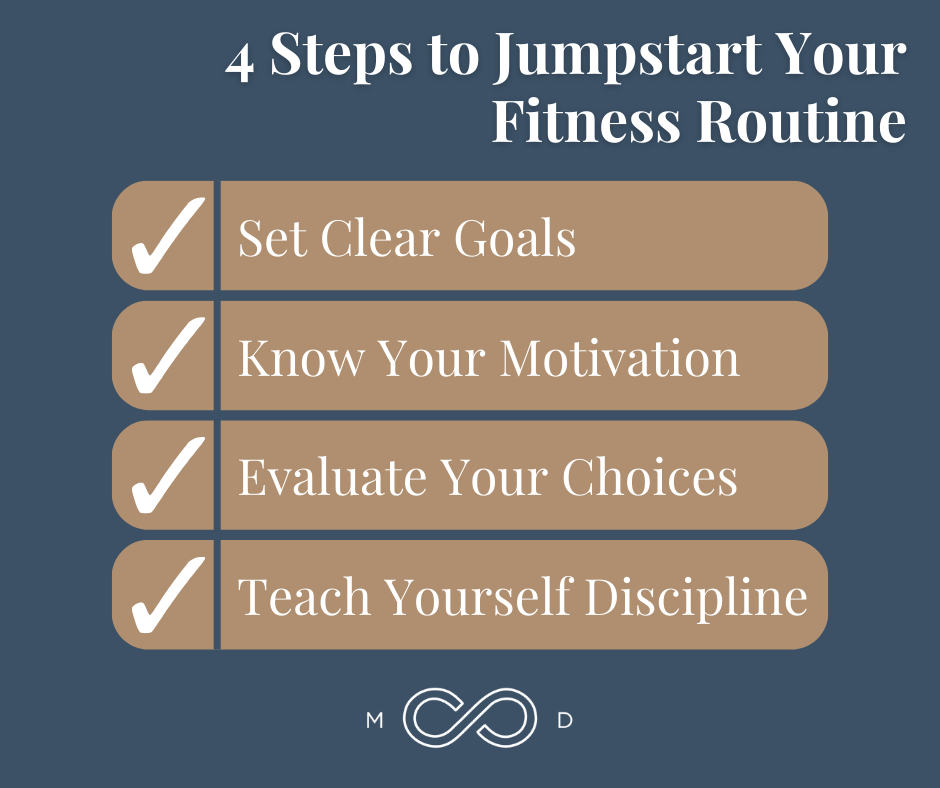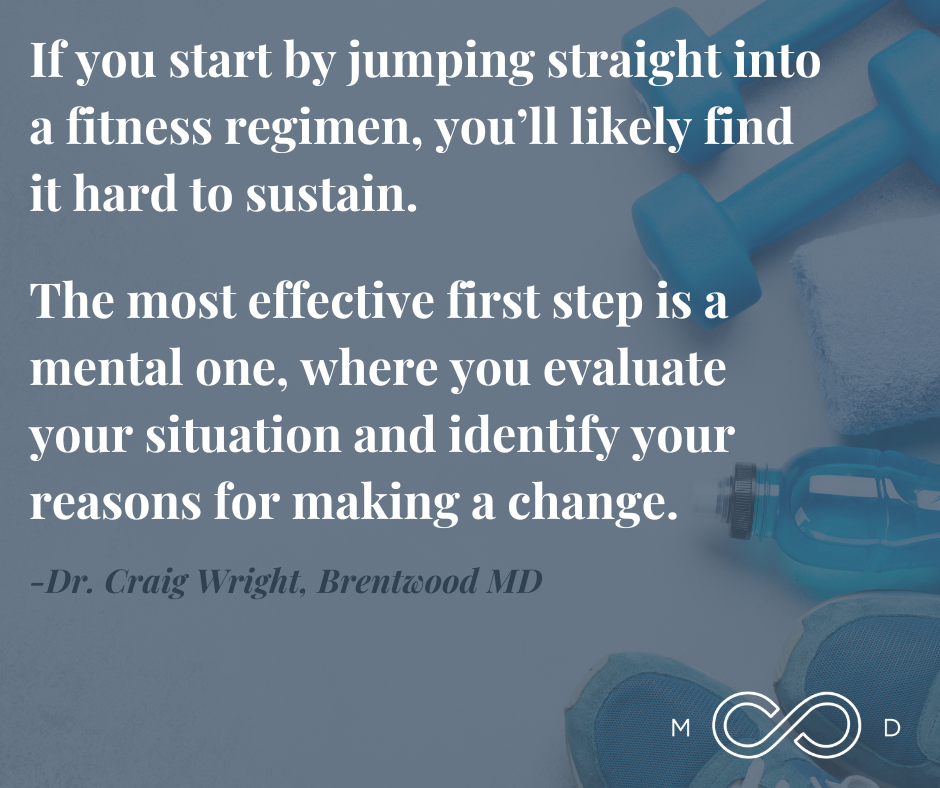Anything worth achieving is going to be difficult, whether it’s a promotion at work, building a house, or something else entirely.
For me, becoming a doctor was one of those difficult achievements. I knew I wanted to be a doctor at a young age. While I knew the desired end point, I also understood it was going to take a lot of time, effort, and sacrifice to achieve.
Think about the last time you achieved something you were proud of, or something that was really impactful. It was probably challenging, but you knew getting to the end would be worth it.
It’s important to acknowledge the fact that making any kind of change — including a lifestyle shift — is going to involve struggles. But it’s equally important to recognize it’s worth it.
With that as a base, we can now formulate strategies for working through and overcoming those challenges. And one of the most universal areas where we all run into challenges is fitness.
Jumpstart Your Workout Routine With Mental Prep
If you’re looking to jumpstart your workout routine (or make any kind of lifestyle shift), the first step on that journey isn’t physical activity at all. In fact, if you start by jumping straight into a fitness regimen, you’ll likely find it hard to sustain.
The most effective first step is a mental one, where you evaluate your situation and identify your reasons for making a change. This is the mental prep work that helps you take every successive step.
Whatever change you make has to match your mental state. You can craft the most amazing fitness plan on paper, but it will be worthless if it doesn’t fit your life and match your motivation. Similarly, if you aren’t mentally prepared to make a lifestyle shift, a fitness plan will be equally useless.
The best fitness plan for you is one that you’re mentally prepared to take on and that matches your reasons for change. A fitness plan like this helps you recognize the importance of your daily choices, always keeping that foundation of “why” as your decision-making touchstone.
4 Steps to Jumpstart Your Fitness Routine
When you see “steps to jumpstart your fitness routine,” you probably expect advice like, Walk a mile! Take the stairs! Try planks!
But those aren’t the kind of steps I’m talking about. In fact, as you saw in the mental prep section, those physical steps come later. The first steps in a process that builds concrete, lasting change come before you ever step foot in a gym.
The following steps are the process I recommend to help you take on any lifestyle change, including getting a jumpstart on your workout routine.
1. Set Clear Goals
Your first step to achieving any goal is taking a step back to identify it. What are you trying to achieve with this lifestyle shift? When you name it, you can aim for it.
Are you interested in weight loss? More energy? Improved self image? Or maybe you’re trying to meet a goal you and your doctor have for your health, like lower cholesterol or controlled blood sugar. Whatever it is, take the time to identify and articulate it.
Once you identify your broader goal, it’s important to drill down and make it specific. Vague or unclear goals take away the opportunity to celebrate milestones and experience the encouragement of success. They allow subjectivity to creep in: I lost some weight, but it wasn’t really that much.
If your goal is weight loss, make it specific. How much are you looking to lose? 10 pounds? 20 pounds? What’s your timeline for that loss? Being detailed and specific will help you be more objective about the progress you make.
Vague goals live in a hypothetical realm. They live in a mental space where you know you should do something, but you don’t have a specific endpoint to aim for. So they get put off, over and over again.
If you want to jump your workout routine forward, the first step is to get clear and detailed about the changes you’re looking to achieve.
2. Know Your Motivation
Once you’ve identified your specific fitness goals, the next step is to tie them to your “why.” Why do you want to make this change?
Some common motivators for lifestyle change include love, fear, success, reputation, and spiritual motivations. I’ve felt these personally, and I frequently see them in my patients.
The important point here isn’t just to identify that motivator, but also to evaluate it. Is that motivation healthy? Is it life-giving? Pause for a time to really consider.
There’s no right or wrong answer; motivations aren’t inherently good or bad. Fear can be a healthy motivator to jumpstart your workout routine — maybe because you’re conscious of your family’s medical history and working toward prevention. But fear can also be an unhealthy motivator rooted in anxiety or depression. Love can be a healthy motivator (staying fit to be there for your family) or an unhealthy one (seeking others’ approval).
Try to determine if your motivations are life-giving, because those are the ones that will be sustainable and impactful.
For an example of healthy motivation, I love the story of Rudy Ruettiger and the Notre Dame football team. Everything Rudy did was tied to his motivation and passion, and it propelled him to become impactful and influential far more than his innate skill or abilities could have. His story even made it to the big screen — and into a truly inspirational movie.
3. Evaluate Your Choices
The next step is to evaluate the direction of your choices — both the ones you’re making now and the ones you intend to make. How do those choices align with your goals? Do they move you closer to the goal, or farther away?
It’s helpful to start with where you are now. What choices do you make today that are in contrast with your goals? Evaluating the choices you currently make will help you recognize what obstacles and challenges you might need to overcome on your journey.
It’s so easy to drift away from goals when we don’t take the time to evaluate our choices.
Sailing provides a great analogy here. If you decide to sail from your current location to Bermuda, it’s going to take a lot of effort. You have to read the water and the wind, watch the weather, and make constant adjustments. If you get complacent, all those external forces guarantee you’re going to drift off course.
In life, every choice you make is important as you evaluate the direction you’re taking. They stack on top of one another to form the routine of our life. But the minute you stop paying attention, the default is to drift back to the status quo and miss the destination.
4. Teach Yourself Discipline
Even when we know which choices we should make, sometimes self-discipline (or lack thereof) gets in the way of following through.
To start this step, consider: What are two of your best habits? What are two of your worst habits? Identify them, and then think about how discipline contributes to those good habits, and how a lack of discipline contributes to the bad ones.
One trick I’ve learned is to approach discipline in yourself similarly to how you would approach it with your children. We try to teach our children good behaviors and discipline, and we can use that same approach and accountability with ourselves, as well.
For instance, consider what kinds of positive rewards would help reinforce actions that bring you closer to your goals, and what kinds of consequences would keep you from dismantling your progress.
We don’t let our children get away with talking back or blowing off school; we develop a plan to get them on track and keep them disciplined to achieve a goal. You can take the same approach with yourself, recognizing where you’re falling short and recovering through reward or consequence.
And of course, as with your children, remember to have grace for yourself. You don’t need to turn into your own drill sergeant. Being too hard on yourself can actually be an obstacle to your success.
Final Thoughts
To get a jump on your workout routine, don’t move straight into crunches or pushups. Start with these basics. This kind of mental preparation and evaluation is foundational to starting and sustaining any new regimen, and it’s what will lead to the results you’re after.

Dr. Wright joined Brentwood MD in 2022 as the model allows him to spend more time connecting with patients and build a foundation of exceptional care. He is a Nashville native and completed his family medicine residency at the University of Tennessee Health Science Center, where he also served as Chief Resident. He believes that your health deserves a prominent position on your priority list, and would be honored to serve you and your family.









